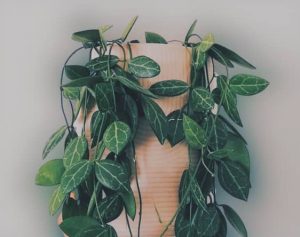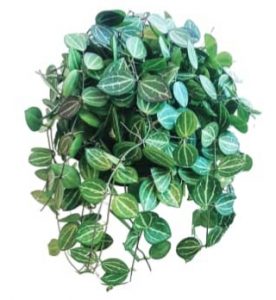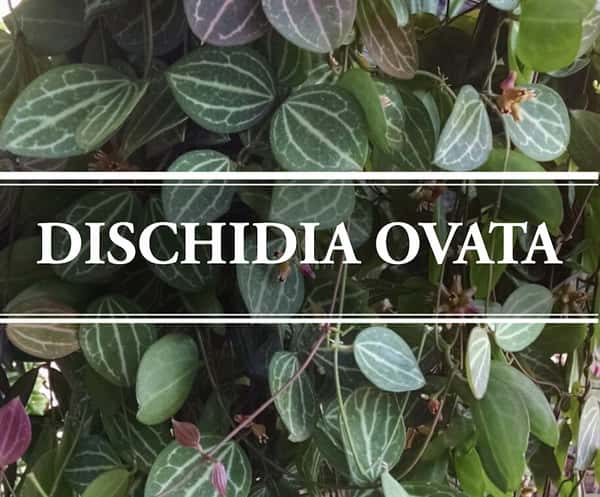Would you like to have an epiphytic climber plant with leaves resembling a watermelon? We are introducing a famous member of the famous milkweed family, the Dischidia ovata plant. The plant trails with the help of small aerial roots growing along with each node. The green oval-shaped leaves with prominent off-white stripes make the plant look nothing lesser than eye candy.
You can make beautiful hanging baskets or mount them on a cork to decorate a terrarium. Interestingly, this attractive vine will not demand much from your time and energy. Yes, even the beginners and the lazy peeps can easily have this low-maintenance peep around. Still with us? Let us know more about the Dischidia ovata watermelon plant along with its care and propagation.
Dischidia Ovata Classification
Family: Apocynaceae
Genus: Dischidia
Species: D. ovata
Dischidia Ovata Common Names
The specific pattern resembling the watermelon gives a number of common names with the plant.
- Watermelon dischidia
- Dischida ovata watermelon
Features of the Dischidia Ovate Plant

Height and Structure
- The creeper grows to several feet in length. However, the height of the plant doesn’t exceed 2 inches.
Flowers
- Apart from the attractive leaves, the plant blooms small non-showy, and non-fragrant flowers. These yellow to pale green flowers with purplish stripes grow in clusters in the growing season.
- Each flower is about 2 to 3 cm in size.
Hoya Dischidia Ovata
The Ovata vine has a close resemblance with the members of the cousin genus Hoya. This makes it sometimes mistakenly known as the Hoya ovata plant.
Dischidia Ovata Care
The Dischidias are easy-to-please peeps. They are low-maintenance plants perfectly suitable for beginners and lazy folks. Let us have a look at the basic care and requirements of the plant.
Water Requirement
The plant can withstand shorter droughts and neglects. But it is not advisable to leave them dry for longer periods. Water the plant frequently letting the upper 2 inches of potting mix dry out between waterings. Now, coming towards the frequency, it depends upon the season, temperature, and humidity of the growing zone. In regions with average temperature, about twice to thrice a week will be enough in summer. However, about once a week seems to be enough for the colder days.
One important part of Watermelon dischidia Care is that it HATES over-watering. So, make sure you are not providing excess water to avoid root rot.
Sunlight Requirement
Bright indirect light is ideal for the Hoya dischidia ovata plant. However, it can survive equally well in shade to partial sun. You can select a well-lit south-facing window behind a curtain to place this striped peep. To fulfil the light requirements of the plant, consider using artificial sources like fluorescent bulbs and growing lights.
The delicate foliage can’t withstand water. Make sure you keep them away from the direct and intense sun.
Excess and inadequate life, both are equally harmful to the plant. If you see the plant’s leaves getting broadly spaced on the thinner stem, this is known as etiolation. This is a sign of the plant not getting enough light. Try placing the plant in some better place with good light.
On the other hand, in case of overexposure, the leaves get a prominent reddish or purple hue on the leaves. If left unattended, this can lead to severe sunburn.
Temperature Requirement
50 to 95 °F is the ideal temperature range for the Dischidia ovata watermelon plant. The plant has poor resistance to cold and frost. So, don’t forget to transfer them to a warm spot before the weather gets cold.
Soil Requirement
The plant needs rich and well-drained soil. Being epiphytes, growing mixtures of big and chunky materials with plenty of aeration do the job. In case of indoor growth, you can use a common houseplant mix for your watermelon Dischidia.
In areas with high humidity, you can grow them in a chunky orchid bark mix or the coconut husk. This will save the plant from rotting. Surprisingly, you can even mount it with some sphagnum moss on a simple piece of cork or bark. We will have a detailed look later in the section on propagation.
Humidity Requirement
The Ovata loves the humid environment. In a dry atmosphere, consider enhancing the moisture level by using a pebble-water tray or a room-humidifier. Nevertheless, you can keep the plant in average moisture level and it will show no resistance for it.
Fertilizer Requirement
Use a diluted or moderate dose of fertilizer, once a month in the beginning days of March. A quarter of the stated dose on a houseplant fertilizer is the ideal dose for your Ovata vine.
Pruning and temperature Requirements
You can remove the older and dead leaves to maintain the health of the plant. Moreover, an overall cut to the creeper is a nice choice for an attractive outlook.
Growth Zones
Ideal USDA growth zones for the Dischidia watermelon plant are 9 to 11.
Dischidia Ovata Propagation

This epiphyte seems to be fond of growing. It has tiny roots on each of its nodes. In addition, these small roots grow to form the rooting system in any suitable medium.
(The part where the leaf is attached to the stem is known as a node).
Propagation by stem cuttings
- Take a sharp knife or shears to cut 5 to 8 inches of the stem.
- Plant these cuttings in a jar of water or a suitable growing mixture.
- Place the set up in indirect light. Keep changing the water weekly to avoid letting it get mucky. On the other hand, the cuttings in the growing mixture need frequent watering. Use a spray bottle to mist the soil right after the upper layer gets about 50% dry.
- About 3 to 4 weeks and the cuttings will show the root growth.
- The water propagated ones can be transferred to soil or potting mixture after about 6 to 8 weeks.
Mounting the Dischidia ovata on cork or bark
There are not many plants that can be mounted on bark or cork. Let us learn this interesting procedure.
- Soak some sphagnum moss in water for a while. Squeeze and remove the excess water.
- Now, take the cuttings and remove the leaves from at least two to three nodes. Pack these nodes with layers of sphagnum moss.
- Take some thread or string to wrap the cuttings. Fix them on the cork inside the terrariums.
- Wait for about 3 to 4 weeks and the cuttings will root to fix their feet. The strings can now be cut out to give a fine outlook.
- Please don’t forget to share your queries and experiences with us. We will be happy to share them with other readers.
Summary
Dischidia ovata is a beautiful epiphytic plant famous for its foliage. The small green egg-shaped leaves have prominent white strips. This pattern makes them look interestingly similar to a watermelon, giving the common name Dischidia watermelon to the plant. It grows to several feet long. Additionally, it does equally well both indoors and outdoors in a suitable atmosphere and temperature.
The dischidia ovata care includes bright indirect light, humidity, and watering after the upper soil gets dry. You can grow this plant to make hanging baskets vases and can mount it on a piece of cork for a terrarium.

